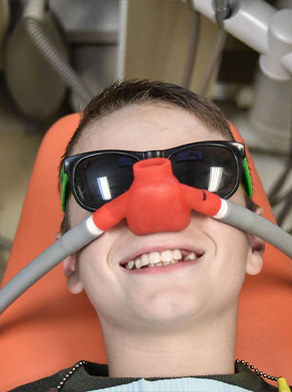Imagine your child undergoing a complex dental treatment like a pulpotimy, stainless steel crown, or oral surgery. When treatment is complete, your child will have no recollection of the time it took, the pain, the noise, or the discomfort. We are pleased to offer your child the option of comfortable, safe, and effective sedation dentistry. Our pediatric dental patients who benefit from sedation dentistry have:
- A fear or anxiety of being at the dentist
- A hard time sitting still for long periods of time
- A hard time getting (and staying) numb from anesthetics
What is sedation dentistry?
Sedation dentistry allows your pediatric dentist to provide a variety of dental treatments safely and comfortably for children who experience anxiety when visiting the dentist. There are several benefits to sedation dentistry, including:
- No memory of undergoing the procedure
- No sense of time while under sedation
- No sense of smell or sound
- No fear or anxiety during treatment
Types of Sedation
Sedation dentistry is closely regulated by law, and there are three sedative states at which your child's dentist can administer treatment:
- Nitrous Oxide - Often called “laughing gas,” nitrous oxide is a very safe, mild sedative that will help your child remain relaxed during dental procedures. Your child’s dentist will give the sedation with the use of a “space mask,” which carries air (oxygen) mixed with the medication. Your child will be asked to breathe through the nose, not the mouth, and will sense a faint, sweet smell. The sedation will take effect in about 5 minutes. The mask will remain in place until the procedure is done. Your child will be awake during the entire procedure and may have a “happy” feeling. When the procedure is complete, the nitrous oxide will be turned off and your child will breathe in pure oxygen for about 10 minutes to clear out any remaining gas. You should limit your child to a very light meal before this procedure, such as toast or a bagel.
- Oral Sedation - If your child is nervous, oral sedation may be used. It is taken by mouth an hour before the procedure. This type of medicine will make your child a little drowsy, and will keep him or her relaxed and calm during the procedure. The medicine usually begins to work within 20 minutes. Your dentist will have your child take the medicine once you arrive at the appointment. If your child is having sedation, he or she should have nothing to eat or drink after midnight the night before the appointment.
- IV Sedation - Intravenous (IV) sedation requires a needle to be inserted into your child’s vein, usually in the arm or hand. The biggest advantage to IV sedation is that the dentist can give your child more medicine during a longer procedure to keep him or her relaxed. Home preparation is required for this type of sedation.
Please contact our practice to schedule a consultation, learn more about sedation dentistry, and find out which sedation dentistry method may be right for your child.





 Website Powered by Sesame 24-7™
Website Powered by Sesame 24-7™